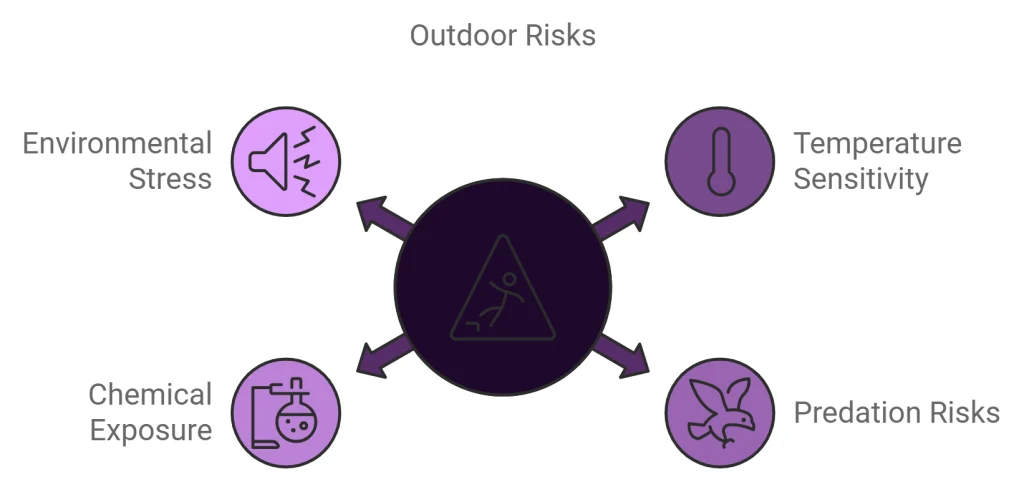Hamsters are beloved for their small size, playful nature, and relatively low-maintenance care. These adorable rodents have become popular pets in households around the world, known for their curiosity and energy. However, many hamster owners may wonder: Can hamsters go outside? While it might seem like a fun idea to let your pet hamster explore the outdoors, there are several important factors to consider when it comes to their safety and well-being.
Is It Safe for Hamsters to Go Outside?

Temperature Sensitivity
Hamsters are extremely sensitive to temperature fluctuations. Their small bodies can’t easily regulate extreme temperatures, making outdoor exposure potentially harmful. In cold weather, hamsters risk entering torpor, a hibernation-like state that can be dangerous if they don’t have enough fat reserves to survive. On the other hand, in hot weather, hamsters can quickly become overheated, leading to heatstroke or dehydration. Whether it’s too hot or too cold, extreme temperatures can cause significant stress and health complications for hamsters.
Predation Risks
As prey animals, hamsters are vulnerable to many outdoor predators, including birds of prey, cats, and even some insects. The presence of these predators, even if a hamster is in a secure enclosure, can create a stressful environment for them. Hamsters have a strong fight-or-flight response, and simply seeing or hearing a predator nearby may cause fear and anxiety, which can lead to long-term health issues.
Chemical Exposure
Outdoor environments often contain chemicals that are harmful to small animals like hamsters. Pesticides, fertilizers, and other lawn treatments can linger in grass and soil, posing a risk if your hamster ingests or comes into contact with these substances. Even a small amount of exposure can lead to poisoning or skin irritation, making it unsafe for hamsters to roam freely in yards or gardens that have been treated with chemicals.
Stress from Outdoor Environments
Hamsters are naturally crepuscular creatures, meaning they are most active during dawn and dusk. Bright sunlight and unfamiliar outdoor sounds can be overwhelming for them. Loud noises from cars, barking dogs, or rustling leaves might cause fear or confusion, leading to high levels of stress. Because hamsters are so sensitive to environmental changes, the unfamiliarity of the outdoors can make them anxious, impacting their overall well-being.
Safe Alternatives for Outdoor Exploration

Supervised Outdoor Time
If you still want your hamster to experience the outdoors, supervised outdoor time in a controlled setting is key. Ensure that your hamster is placed in a secure enclosure, such as a well-ventilated playpen with no gaps for escape. Monitor the temperature closely—avoid taking them outside during extreme heat or cold, and always provide a shaded area to prevent direct sunlight exposure. It’s important that the surface, like grass, is free from pesticides and fertilizers, and the area is free from predators. Outdoor excursions should be short and closely monitored to ensure your hamster remains comfortable and safe.
Indoor Exploration Alternatives
A safer and equally enriching alternative to outdoor time is creating an indoor environment that allows your hamster to explore while mimicking natural textures. You can design a small indoor habitat using safe materials like untreated grass, herbs, or coco fiber. This way, your hamster can enjoy digging and foraging in a familiar, controlled space without the risks that come with being outdoors. Changing the layout or adding new textures periodically can stimulate your hamster’s curiosity and prevent boredom.
Using Playpens
Playpens offer a great way for your hamster to explore in a safe environment, whether indoors or in a sheltered outdoor area. A secure playpen with high walls and smooth surfaces prevents escape and protects against predators. Even within a playpen, supervision is critical, as hamsters are skilled at finding ways to climb or burrow. Whether placed indoors or outdoors, playpens allow your hamster to explore while minimizing risk, as long as you’re there to keep an eye on them.
Conclusion
In conclusion, while it’s possible to allow hamsters to go outside under very controlled and supervised conditions, it’s generally safer to keep them indoors. Indoor environments are free from temperature extremes, predators, and harmful chemicals, all of which pose significant risks to your hamster’s health and well-being. By providing a stimulating indoor setup with safe textures and toys, you can meet your hamster’s need for exploration without exposing them to the dangers of the outdoors. Supervised outdoor time may be enjoyable on rare occasions, but it’s not ideal for their long-term happiness and safety.

